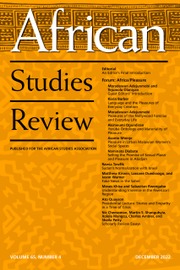In his compelling book, Riotous Deathscapes, Hugo ka Canham examines how the amaMpondo, a marginalized subgroup of the regionally dominant Xhosa people in South Africa’s rural Eastern Cape, find meaning and forge identities amid poverty, violence, and death. Using the isiMpondo method of ukwakumkanya—an isiMpondo term that refers to shielding one’s eyes to block the sun and see far—Canham offers a phenomenological study of black life under (post)colonial-apartheid conditions that avoids both Afropessimism and triumphant Afropolitanism to introduce “Mpondo theory”—a fresh contribution to Black Studies from Africa, engaging Indigenous and queer theories while challenging and engaging with black-diasporic perspectives from the Caribbean and Global North. Canham argues that Mpondo theory works beyond the gaze to include all sensory ways of knowing and being. Through archival research, interviews, and personal experiences, Riotous Deathscapes disrupts Western ideas of humanity and death, calling for a broader understanding of materiality and black life.
What is most innovative about this book is how Canham uses an autoethnographic platform to focus on human experience, black life and death, bringing together Indigenous (native survivance) and black ways of knowing (black livingness). He advocates a framework for understanding decoloniality based on Indigenous ways of thinking across space and time that are “rooted in place” (25), but also “in relation” (22) as a path forward “to breach colonial epistemes” (23). His decolonial framework represents an evolution of Indigenous and black epistemologies and highlights intersections of histories of trauma. Canham argues that these terms or states/conditions should not be read as “mutually exclusive” but “could productively be seen as both potentially making and unmaking each other” (22). Mutual engagement and terms of reference that are nonhierarchical and nonextractive work toward the “unenclosed” (14), which Canham offers as a method/way of moving forward across time and space. These new ways and forms of knowledge act as “confluences” (borrowing from Glissant) of experience and history that are found beyond colonial mapping, but where landscape and geography are paramount to identity processes.
Canham explains that there are two audiences for the book—the rural public and the scholarly public—and when considered together, they create “spaces of relation” (31). Chapters can be read alone, although a narrative thread builds progressively across the chapters as “each chapter plays with temporality by moving between timescapes” which Canham terms “cylindrical epiphenomenal temporality” (33). Furthermore, each chapter focuses on an ancestral figure who interfaces with “contemporary protagonists” (33) creating an interesting journey tapestry.
In Chapter One he develops Mpondo theory and reads the ocean and the mountain rock face as “scripts” (37) through which to ponder the past as a “vast deathscape” and begin building an archive based on black and Indigenous experience rather than colonial master narrative (37). He stresses the importance of ancestors in the path forward and contends that African blackness is always in relation, drawing heavily on Glissant’s “conception of relation as central to identity” (41). Chapter Two probes Mpondo theory more in depth through a focus on historical events, such as: the sinking of the SS Mendi in 1917; the story of the prophetess Nontetha Nkwenkwe, who died in prison in 1935; and the Mpondo rebellion of the 1950s that led to the 1960 revolt. Chapter Three’s goal is to upend the colonial gaze and prove that a “queer erotic” can be part of the African experience” (138). Canham proffers that black queer freedom is possible through “ukukhuphuka izizwe” or possession. He provides an account of the early 1900s exorcism of a young Zulu speaking woman, Clara Germana Cele, who was “constructed as a riotously queer body that is so evil that her story has traveled for over a century” (127). He contrasts the colonial account with descriptions of a contemporary Twitter performance piece of a school exorcism.
In Chapter Four, he evokes the case of Sarah Baartman “to provide a cylindrical echo” of this Khoekhoe woman taken into captivity by an Englishman, exhibited in London and Paris, and who died in 1815 at the age of twenty-seven. According to Canham, her body, which “epitomized the black body as spectacle in both life and death,” is just one example of the riotous nature of the deathscape (143–46). In Chapter Five, Canham returns to Ngquza Hill (introduced in Chapter Two) to probe the “supernatural as technology for rural life” (191). He contends that these practices of vampirism and cannibalism work to queer and parody consumption, going so far as to say that cannibalism is derived to a certain extent from colonial violence and the AIDS epidemic.
Canham’s style in the book is poetic, musing, and often emotional. His methodology of co-producing knowledge with villagers and elders via interviews is an illustration of the Indigenous principle of community and sharing. Canham achieves his goal of writing beyond the strictures of time and moving beyond the telling of colonial histories from a colonial point of view and successfully demonstrates that riotous deathscapes are ways of living and dying and are “self-affirmative cultural practices” that allow one to move toward freedom. By standing and writing at the site of history and histories, Canham creates a most profound narrative of return through which he links landscape, beauty, trauma, and survival.


